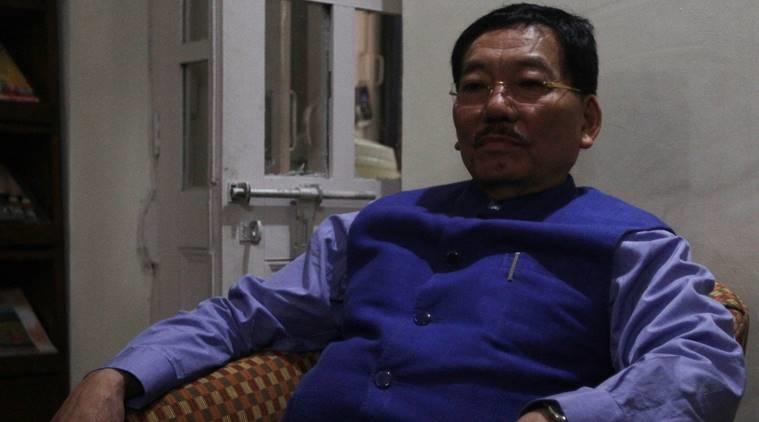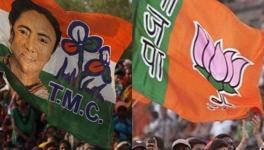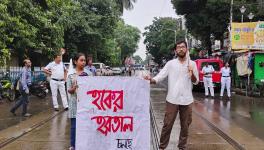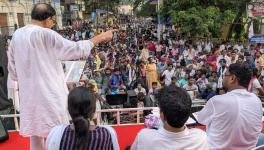Is the SDF Gearing up for the 2019 Polls?

Recent reports have quoted the Chief Minister of Sikkim, Pawan Kumar Chamling, who is making certain statements about the relations between his Sikkim Democratic Front (SDF) government and the Union Government. It is uncharacteristic of the Sikkim government to publicly pass comments on their federal relations. Considering this, one could term the comments as firing the shots for the 2019 polls. On Monday, he was widely reported as saying that he was never informed about the Doklam stand-off between June and August last year. He said that all the information he received was through the media. The primary opposition party in Sikkim, the Sikkim Krantikari Morcha (SKM) has termed this statement as 'anti-national'. Chamling also reiterated his demand for a 'peace bonus' of Rs. 1,000 crore for the state.
The anti-SDF and anti-corruption SKM, led by Prem Singh Tamang (Golay) who was recently released after serving a one-year term for embezzling funds as the minister for animal husbandry, lashed out at Chamling on the Doklam issue. However, if what Chamling states is true, it does not bode well for India's 'cooperative federal' structure. Nathu La, which is the closest point in Sikkim to Doklam, is around 50 kilometre from Gangtok, or a little under a two-hour drive, provided one does not get caught in a traffic jam. Though unlikely, if the situation had escalated, the lack of coordination between the Army and Union Government on one side, and the government of Sikkim on the other, could have had catastrophic implications.
The issue of the peace bonus has been reiterated by Chamling's government for the past 10 years. Mizoram, which had witnessed several insurgencies – from the Mizo National Front (MNF)-led insurgency to the later Hmar and Bru insurgencies – received a 'peace bonus' of 182.45 crore in 2000. Chamling has raised the demand highlighting that his government had isolated Sikkim from the unrest in Nepal during the Maoist insurgency as well as during the Gorkhaland agitations. In fact, a National Democratic Front for Bodoland (NDFB) leader had even been arrested in Gangtok in 2003. The NDFB is an Assam-based armed political group fighting for Bodoland. Several factions are currently in talks with the Union Government, while one faction has joined the United National Liberation Front for Western South East Asia (UNLFW).
Though these were the two issues that Chamling had raised in the press meeting in Gangtok, there are several issues which could cause his party's grip on power to waver in 2019. These are: the Sherpa land issue, Limboo-Tamang seats issue, Scheduled Tribe (ST) status for eleven communities, drug addiction, and unemployment.
A Sherpa organisation called the Denzong Sherpa Association (DSA) has been campaigning for the Sherpa community to be counted as Bhutias in the Land Revenue Order No. 1. This Order is a remnant of one of the pre-merger laws of Sikkim that made special provisions protecting the land rights of the Bhutia and Lepcha communities. The Cabinet government had instead approved an amendment to the Sikkim Regulation of Transfer of Land (second amendment) Bill 2018 so as to include the Sherpa community. The law is one which seeks to restrict land alienation of various communities and in particular, agricultural land. The government's position on the DSA's demands is that amending the land revenue order would be tantamount to diluting Article 371F – a Constitutional provision bestowing a 'special' status to Sikkim. The DSA hit back, stating that Sikkim's old company law, the Registration of Companies (Sikkim) Act, 1961 – which provided for certain tax exemptions – in favour of the Companies Act, 2013, had been repealed. This too could be construed as a dilution of Article 371F.
The Limboo-Tamang seats issue has been burning for around 16 years. The Limboo and Tamang communities have received ST status, and as a result, they have been campaigning for seats to be reserved for them in the legislative assembly. This is not an easy issue on several grounds. Firstly, because the pre-merger assembly under the 8th May Agreement had seats reserved for the Nepali, Bhutia and Lepcha communities. The Bhutia and Lepcha communities together have 15 seats in the 32-member assembly, and the Nepali community would have 15 seats, one seat was reserved for the Sangha and one seat for the Scheduled Castes. However, post-merger in 1978, the Bhutia and Lepcha communities were designated STs, hence their seats were protected as ST seats. The Nepali seats however became classified as 'general' seats. Thus, the provisions of the 8th May Agreement – on which Article 371F is based – have been diluted.
When the Limboo and Tamang communities received ST status in 2002, it would automatically imply that despite being Nepali communities, they could contest the ST seats. However, this was never done. Instead, the Bhutia and Lepcha communites demanded that the seats to be reserved for the Limboos and Tamangs should be given out of the existing share of Nepali seats. But, the Nepali seats did not exist, since they were all classified as general. To remedy this, the Chamling government has been petitioning for the Sikkim Assembly to be expanded so that the Limboo and Tamang communities can be accommodated. This too has run into hot water as the Bhutia and Lepcha communities have demanded that the number of seats allocated to them also be increased so that the ratio of the shares does not get affected.
The ST status issue is one that has ramifications across India. This is because the eleven communities are designated 'Nepali' in Sikkim and 'Gorkha' everywhere else in the country. The eleven communities are Gurung, Mangar, Rai, Sunwar, Mukhia, Jogi, Thami, Yakha, Bahun, Chettri and Newar. One could always go into the merits of terming these communities as ST, for example the Bahun and Chettri communities are respectively the Brahmin and Kshatriya castes of the Khas community. Within the Nepali caste dynamics, they are members of the thulo jat – upper castes. On another note, the chief minister himself belongs to one of these communities – Rai. In North Bengal several prominent local elites also belong to these communities; political leader Bimal Gurung is one example. On the other hand, these communities also make up a sizeable portion of the tea garden work force in Darjeeling. It is clear that for many, the issue is more about 'reservation' than anything else. Though in terms of merits, ST status is more likely to benefit the elites from these communities.
However, it is still a powerful electoral weapon that across the border in the Darjeeling Hills, the two factions of the Gorkha Janmukti Morcha and their non-local backers – the Trinamool Congress and the Bharatiya Janata Party – are battling to claim legitimacy in pushing the demand.
The SDF government has indicated that they would be tackling the issues of unemployment and drug abuse in the state. On August 8, the chief minister stated a policy shift in approaching drug abuse. At the Tendong Lho Rum Faat celebration in Saramsa Garden in East Sikkim, he announced that drug abuse would be treated as a disease, and not a crime.
On the issue of unemployment, the challenges are more severe. On one hand, through pursuing the environmentally friendly policies of declaring vast swathes as reserved forest, herding is a disappearing livelihood. On the other hand, the environmentally unfriendly policies of hydro-electricity projects has deprived those dependent on river-based livelihoods. However, the non-organic ban and the subsequent chaos could be construed as not only a protectionist policy, but also to make commercial horticulture and agriculture more lucrative in meeting the state's food demands.
On July 30, the chief minister also announced a policy whereby every family would have at least one member with a government job. This is clearly a populist band-aid which plays to the local prejudices regarding employment. Whereby, when one says that they have a 'job', they mean a government job, other forms of employment apparently do not count.
This picture shows that the Chamling-led SDF government has a lot on its plate within the state. However, by commenting on Sikkim's relation with the Union Government, it appears to be a tactic to deflect the issues confining them to an insider-outsider paradigm. The SDF government has, in the past, been quick to comment on 'outside forces' spreading communal poison in the state. However, this narrative may buy the SDF time until the 'band-aid' measures come apart. What is telling is that by resorting to the paradigm, the present government shows that it is unsure of its ability to make a clean sweep of the upcoming polls as it has done since 1994.
Get the latest reports & analysis with people's perspective on Protests, movements & deep analytical videos, discussions of the current affairs in your Telegram app. Subscribe to NewsClick's Telegram channel & get Real-Time updates on stories, as they get published on our website.
























